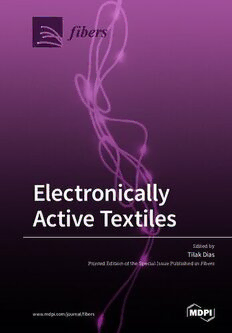Table Of ContentE
le
c
t
r
o
n
ic
a
lly
A
c
t
iv
e
T
e
x
t
ile
s
• T
ila
k
D
ia
s
Electronically
Active Textiles
Edited by
Tilak Dias
Printed Edition of the Special Issue Published in Fibers
www.mdpi.com/journal/fibers
Electronically Active Textiles
Electronically Active Textiles
SpecialIssueEditor
TilakDias
MDPI•Basel•Beijing•Wuhan•Barcelona•Belgrade
SpecialIssueEditor
TilakDias
NottinghamTrentUniversity
UK
EditorialOffice
MDPI
St.Alban-Anlage66
4052Basel,Switzerland
ThisisareprintofarticlesfromtheSpecialIssuepublishedonlineintheopenaccessjournalFibers
(ISSN2079-6439)from2018to2019(availableat: https://www.mdpi.com/journal/fibers/special
issues/electronicallyactivetextiles)
Forcitationpurposes,citeeacharticleindependentlyasindicatedonthearticlepageonlineandas
indicatedbelow:
LastName,A.A.; LastName,B.B.; LastName,C.C.ArticleTitle. JournalNameYear,ArticleNumber,
PageRange.
ISBN978-3-03928-144-2(Pbk)
ISBN978-3-03928-145-9(PDF)
CoverimagecourtesyofTilakDias.
(cid:2)c 2020bytheauthors. ArticlesinthisbookareOpenAccessanddistributedundertheCreative
Commons Attribution (CC BY) license, which allows users to download, copy and build upon
publishedarticles,aslongastheauthorandpublisherareproperlycredited,whichensuresmaximum
disseminationandawiderimpactofourpublications.
ThebookasawholeisdistributedbyMDPIunderthetermsandconditionsoftheCreativeCommons
licenseCCBY-NC-ND.
Contents
AbouttheSpecialIssueEditor . . . . . . . . . . . . . . . . . . . . . . . . . . . . . . . . . . . . . . vii
Prefaceto”ElectronicallyActiveTextiles” . . . . . . . . . . . . . . . . . . . . . . . . . . . . . . . ix
TheodoreHughes-Riley,TilakDiasandColinCork
AHistoricalReviewoftheDevelopmentofElectronicTextiles
Reprintedfrom:Fibers2018,6,34,doi:10.3390/fib6020034 . . . . . . . . . . . . . . . . . . . . . . . 1
AlyssaMartinandAdamFontecchio
Effect of Fabric Integration on the Physical and Optical Performance of Electroluminescent
FibersforLightedTextileApplications
Reprintedfrom:Fibers2018,6,50,doi:10.3390/fib6030050 . . . . . . . . . . . . . . . . . . . . . . . 16
Mohamad-NourNashed,DorothyAnneHardy,TheodoreHughes-RileyandTilakDias
A Novel Method for Embedding Semiconductor Dies within Textile Yarn to Create
ElectronicTextiles
Reprintedfrom:Fibers2019,7,12,doi:10.3390/fib7020012 . . . . . . . . . . . . . . . . . . . . . . . 29
DorothyA.Hardy,AndreaMoneta,ViktorijaSakalyte,LaurenConnolly,ArashShahidiand
TheodoreHughes-Riley
EngineeringaCostumeforPerformanceUsingIlluminatedLED-Yarns
Reprintedfrom:Fibers2018,6,35,doi:10.3390/fib6020035 . . . . . . . . . . . . . . . . . . . . . . . 46
PasinduLugoda,TheodoreHughes-Riley,CarlosOliveira,RobMorrisandTilakDias
DevelopingNovelTemperatureSensingGarmentsforHealthMonitoringApplications
Reprintedfrom:Fibers2018,6,46,doi:10.3390/fib6030046 . . . . . . . . . . . . . . . . . . . . . . . 58
v
About the Special Issue Editor
TilakDiasobtaineda‘Diplom-Ingenieur’intextileengineeringfromtheTechnischeUniversita¨tin
Dresden in 1981 after studying electrical and electronics engineering in 1969. He also obtained a
‘Dr.-Ingenieur’fromtheUniversita¨tStuttgartin1988. ProfessorDiashasheldtheChairinKnitting
at Nottingham Trent University (United Kingdom) since 2010, where he is also the Head of the
AdvancedTextilesResearchGroup. Hehasover38yearsofexperienceinknittedstructuredesign
andknittingtechnology,and17yearsofexperienceindevelopingelectronictextiles. Tilakhasbeen
invitedtogiveover60talksandhaspublishedover160scientificpapersinleadingjournalsand
conferences. Hisresearchfocusesonthedevelopmentofelectronictextilesandadvancedknitting
technologies.
vii
Preface to ”Electronically Active Textiles”
Sincetheirinvention,textilematerialshavegonethroughmanyevolutions. Initially,thefocus
wasonenhancingaestheticproperties(suchastheircolour,handle,andcomfort).Inthelastcentury,
the focus moved to improving textile functionality. This has led to the development of fabrics
capableofstoppingabullettravellingatsupersonicspeeds,offireretardantfabrics,andofimpact-
andcut-resistantfabrics. Allthesefunctionalitieshavebeenachievedusingchemicalprocessesand
throughadvancesinpolymerscience.
Textilesarenowgoingthroughanewevolutiontointegrateelectricalsystemsandelectronic
devices. Textilesareusedtoclotheourbodiesbecausetheyarestrong,soft,breathable,flexible,and
conformable. Theintroductionofelectroniccomponentshasthepotentialtocompromisesomeof
thesehighly-desirablecharacteristics; however, theproperintegrationwouldresultinintroducing
intelligencetotextilematerialsforthefirsttime.
Thisbookcontainsfivepeer-reviewedarticlesthatreviewthedevelopmentofelectronictextiles
(e-textiles)andoriginalresearcharticles. Topicsincludethefabricationandtestingofe-textiles,the
illuminationofe-textiles,ande-textilesthatcanmonitorskintemperature.Thisvolumewillbeuseful
asareferencefordesignersandengineersinbothacademiaandindustrywhowouldliketodevelop
anunderstandingofe-textiles,aswellastostudents.
TilakDias
SpecialIssueEditor
ix

